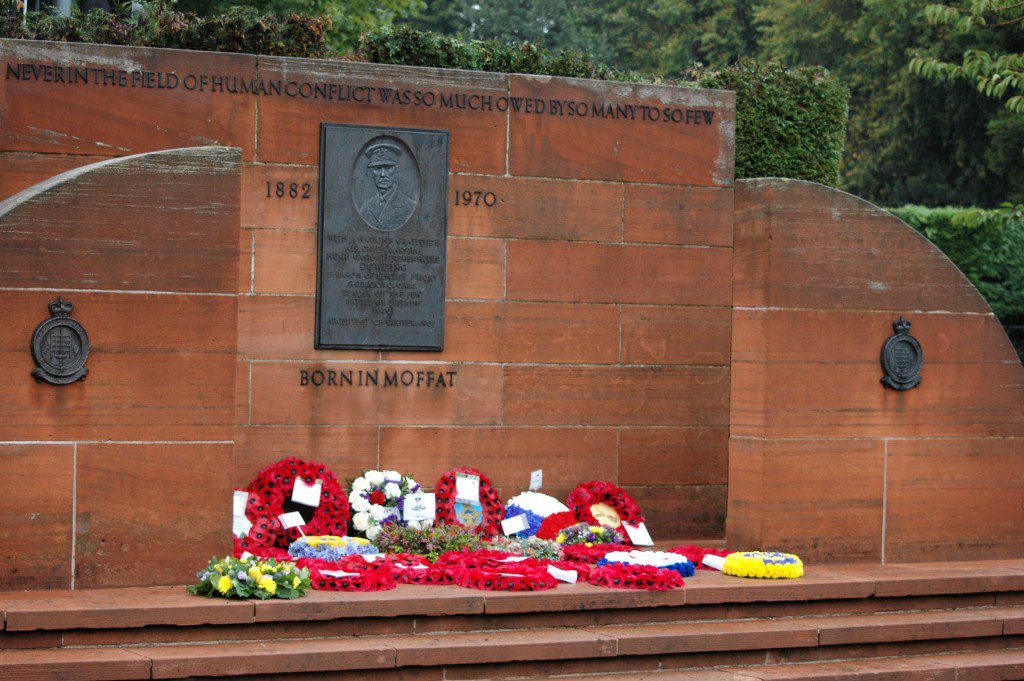As you may already know, uncertainty about the Covid restrictions caused the cancellation of this year’s Moffat Commemorative Service for Lord Dowding. However, the good news is that the Battle of Britain Memorial Flight have confirmed that two Spitfires will carry out a flypast on Sunday 5th September, at 1430 hours, weather permitting.
At 1430 hours, there will also be a simple ceremony of laying three wreaths at the memorial in Station Park, on behalf of Lord Piers Dowding, Lady Odette Dowding and the Town of Moffat.
Everyone is very welcome to attend.

Moffat is proud to have been the birthplace of Air Chief Marshal Hugh Dowding. A memorial stands in his honour in the town’s Station Park and, each September, a service is normally held here in his memory. To many, he was known as The Architect of Deliverance.
Air Chief Marshal Hugh Caswall Tremenheere Dowding, 1st Baron Dowding, GCB, GCVO, CMG (24 April 1882 – 15 February 1970) served as a fighter pilot and then as commanding officer of No.16 Squadron during the First World War. During the inter-war years he became Air Officer Commanding Fighting Area, Air Defence of Great Britain and then joined the Air Council as Air Member for Supply and Research. He was Air Officer Commanding RAF Fighter Command during the Battle of Britain and is generally credited with playing a crucial role in Britain’s defence, and hence, the defeat of Adolf Hitler’s plan to invade Britain.
During the Second World War, France was not defeated and occupied by Germany until June 1940. This gave them the platform for the invasion of Great Britain, to be preceded by the air assault which we now remember as the Battle of Britain.
But, in 1939, there were several important actions over Scotland involving Fighter Command, two of which are described here.
On the 16th October, 1939, the Luftwaffe’s Fleigerdivision’s I/KG 30, based at Westerland on the Island of Sylt, despatched nine Junkers 88 dive bombers, under the command of Hauptmann Helmuth Pohle. Their main objective was to bomb HMS Hood, reputed to be docked at Rosyth. Ironically Pohle was under orders from Hitler that he was not to bomb if there was a danger of civilian casualties!
They did not expect any real opposition as the crews had been told that Scotland was defended by obsolescent Gloster Gladiators. But, in fact, there were Spitfires of 602 (City of Glasgow) and 603 (City of Edinburgh) Squadrons at Drem (now East Fortune) and Turnhouse respectively.
The attack was a failure: Pohle was shot down in the Forth but managed to guide his doomed aircraft to ditch alongside a trawler. The crew rescued him, severely concussed, and he awoke five days later in hospital. The Luftwaffe lost four aircraft and five were badly damaged; all the downed aircraft fell into the sea; one of the enemy losses was a Heinkel 111, sent to observe the Junkers attack. There were no RAF losses.
On the 29th November, 1939, Archie McKellar, DSO, DFC & Bar (10 April 1912 – 1 November 1940) of 602 Squadron, spotted a Heinkel 111 over Dalkeith and attacked it, killing the dorsal gunner and damaging the aircraft. As he was about to attack a second time, two Spitfires from 603, under the command of Sqn Ldr E.H. Stevens, nipped in and shot it down, landing in a field at Kidlaw, near Haddington, East Lothian. It was the first enemy aircraft of the war to be downed on British soil.
The Moffat Museum (just along the road from Station Park, as you walk into town) will be open from 11-4 on Sunday 5th. In addition to their online ‘Dowding – the Man’ exhibition at https://moffatmuseum.co.uk/dowding-introduction/ an expanded exhibition is now on display in the Museum, where more has been added to what is online. In later life, Dowding became a vegetarian, based on his beliefs as a theosophist and spiritualist.






